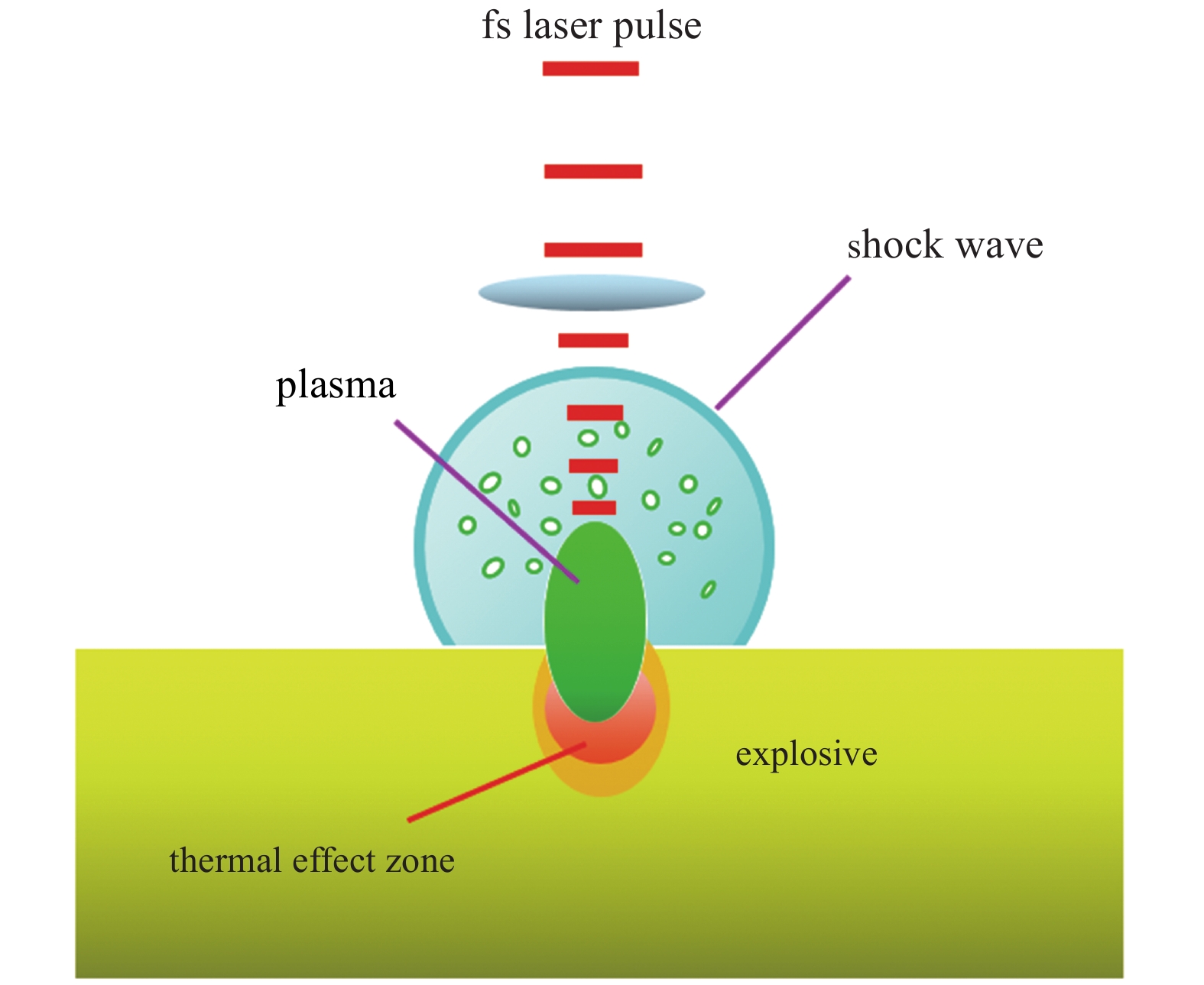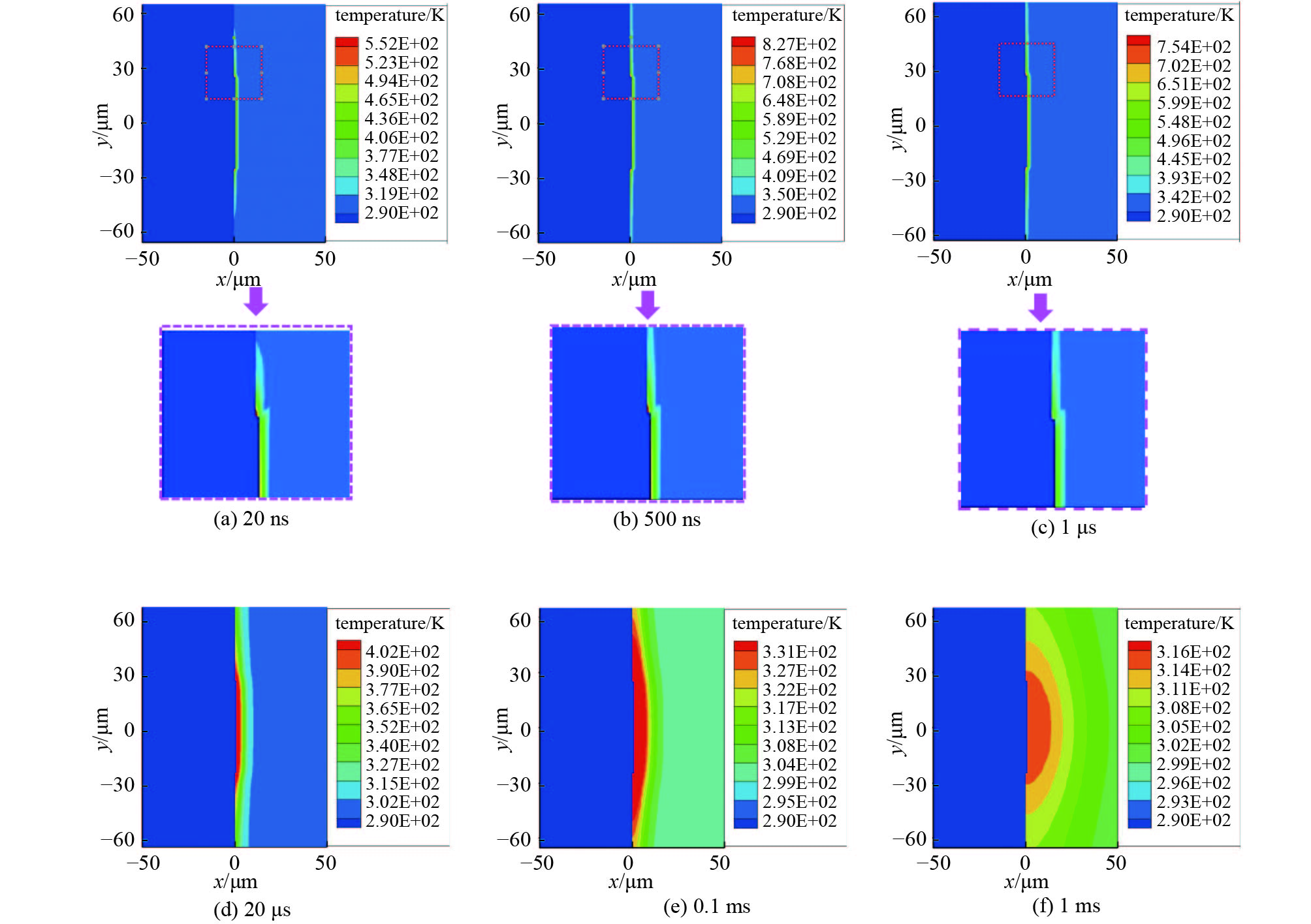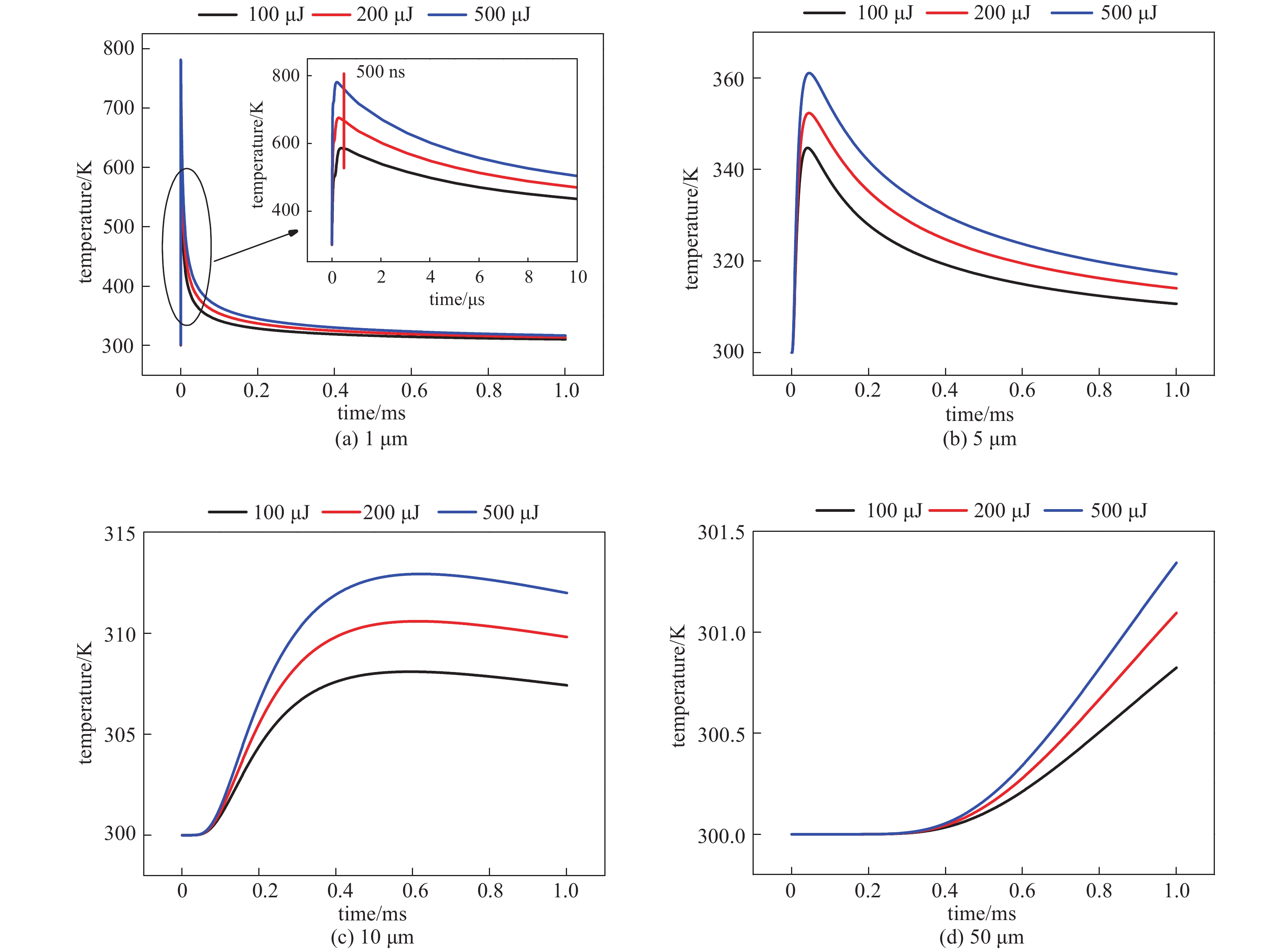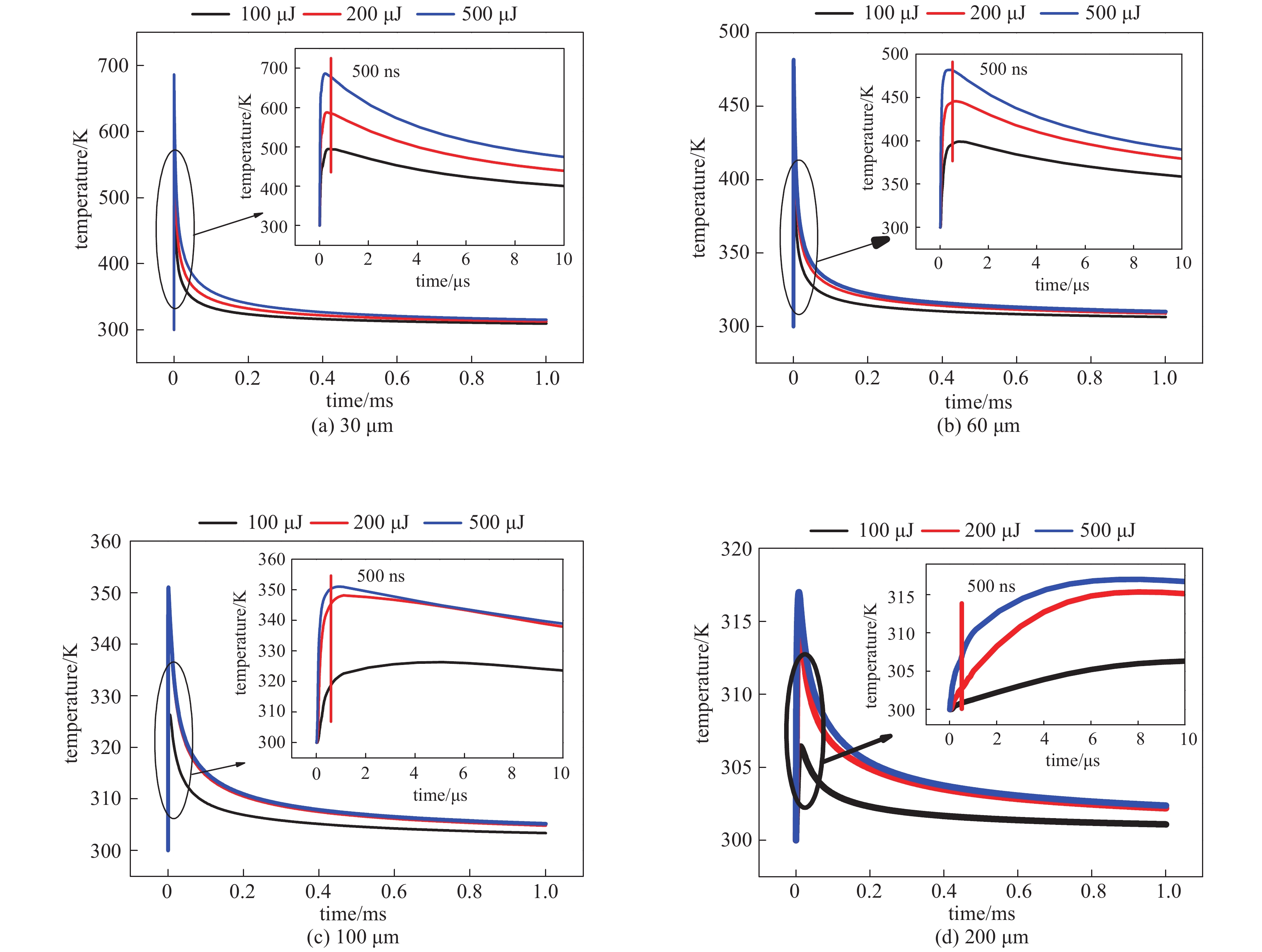Analysis of thermal effect on explosives of single-pulse femtosecond laser ablation
-
摘要: 飞秒激光能够在极短时间内烧蚀炸药产生高温高压等离子体。可以利用飞秒激光对含能材料或含能元器件进行精密加工。深入认识飞秒激光烧蚀炸药过程中,炸药内部的热效应是发展飞秒激光加工炸药技术的基础。建立了单脉冲飞秒激光烧蚀炸药过程的流固耦合计算模型,考虑了在高温高压等离子体和炸药自热反应的共同作用下,炸药内部的热效应。对飞秒激光烧蚀TNT炸药过程进行了流体力学数值模拟。计算结果表明:TNT炸药中未烧蚀区域产生了热效应,峰值温度高于TNT炸药的点火温度,但由于炸药内热效应区域极小,高温持续时间极短,因此炸药内温度迅速下降,没有发生点火现象。Abstract: Femtosecond laser can ablate explosives to generate a high-temperature, high-pressure plasma in extremely short time. The femtosecond laser can be used to precisely process energetic materials or assemblies containing energetic materials. Deep understanding of the thermal effects within the explosives during femtosecond laser ablation is the basis for the development of the safe processing technology of explosives using femtosecond laser. A fluid-solid coupling calculation model of single-pulse femtosecond laser ablation of explosives was established to study the combined thermal effect of the thermal radiation of the plasma and the autothermal reaction of the explosives. The hydrodynamic process of femtosecond laser ablation on TNT was calculated. The results show that in the unablated zones of the explosive, significant thermal effect was detected, and the peak temperature is higher than that of ignition. Due to the small zones affected by the thermal effect and its extremely short duration time, the temperature in the explosive drops quickly, thus the explosive is not ignited.
-
Key words:
- femtosecond laser /
- laser ablation /
- plasma /
- explosive /
- numerical simulation
-
表 1 TNT的物性参数
Table 1. Physical properties of TNT
explosive density/(kg·m−3) specific thermal capacity/(J·kg−1·K−1) thermal conductivity/(W·m−1·K−1) ignition temperature/K TNT 1 580 1 380 0.5 513 表 2 TNT的多步热分解反应动力学参数
Table 2. Kinetic parameters of multi-step thermal decomposition reaction of TNT
step E/(kJ·mol−1) Z/s−1 Q/(kJ·kg−1) 1 200.000 6.0×1014 −125.575 2 144.412 1.957×1012 3 767.267 3 140.226 2.391×1013 3 592.840 -
[1] 王清月. 飞秒激光在前沿技术中的应用[M]. 北京: 国防工业出版社, 2015.Wang Qingyue. Femtosecond laser application in advanced technologies[M]. Beijing: National Defense Industry Press, 2015 [2] Chin A H, Schoenlein R W, Glover T E, et al. Ultrafast structural dynamics in InSb probed by time-resolved X-ray diffraction[J]. Physical Review Letters, 1999, 83: 336-339. doi: 10.1103/PhysRevLett.83.336 [3] 杨建军. 飞秒激光超精细“冷”加工技术及其应用[J]. 激光与光电子学进展, 2004, 41(4):42-52. (Yang Jianjun. Femtosecond laser “cold” micro-machining and its advanced applications[J]. Laser & Optoelectronics Progress, 2004, 41(4): 42-52 [4] Roeske F, Banks R E, Armstronget J P, et al. Laser cutting of pressed explosives [R]. UCRL-JC-128373 Rev 1, 1998. [5] Roos E V, Benterou J J, Lee R S, et al. Femtosecond laser interaction with energetic materials[C]// Proc of SPIE. 2002, 4670: 415-423. [6] Palmer J A, Welle E J. An ultrashort pulse laser lathe for axisymmetric micromachining of explosives[C]//Proc of SPIE. 2007: 646015. [7] Mcgrane S D, Grieco A, Ramos K J, et al. Femtosecond micromachining of internal voids in high explosive crystals for studies of hot spot initiation[J]. Journal of Applied Physics, 2009, 105: 073505. doi: 10.1063/1.3091270 [8] Qiu T Q, Tien C L. Short-pulse laser heating on metals[J]. International Journal of Heat and Mass Transfer, 1992, 35: 719-726. doi: 10.1016/0017-9310(92)90131-B [9] Michael D P, C. Stuart, P S, Banks, et al. Laser machining of explosives: US6150630[P]. 2000-11-21 [10] Howell J R, Siegel R, Mengüç M P. Thermal radiation heat transfer[M]. New York: Taylor & Francis Group, 2010. [11] Cheng P. Theory of two-dimensional radiating gas flow by a moment method[J]. AIAA Journal, 1964, 2: 1662-1664. doi: 10.2514/3.2645 [12] Luan Y T, Chyou Y P, Wang T. Numerical analysis of gasification performance via finite-rate model in a cross-type two-stage gasifier[J]. International Journal of Heat and Mass Transfer, 2013, 57: 558-566. doi: 10.1016/j.ijheatmasstransfer.2012.10.026 [13] Isbell R A, Brewster M Q. Optical properties of energetic materials: RDX, HMX, AP, NC/NG, and HTPB[J]. Propellants, Explosives, Pyrotechnics, 1998, 23: 218-224. doi: 10.1002/(SICI)1521-4087(199808)23:4<218::AID-PREP218>3.0.CO;2-A [14] Aduev B P, Belokurov G M, Nurmukhametov D R, et al. Studying the optical properties of hexogen–aluminum composites[J]. Optics & Spectroscopy, 2018, 125(5): 632-639. [15] MeGuire R R, Tarver C M. Chemical decomposition models for the thermal explosion of confined HMX, TATB, RDX and TNT explosive[C]//Proceeding of the 7th International Detonation Symposium. 1981. -






 下载:
下载:










